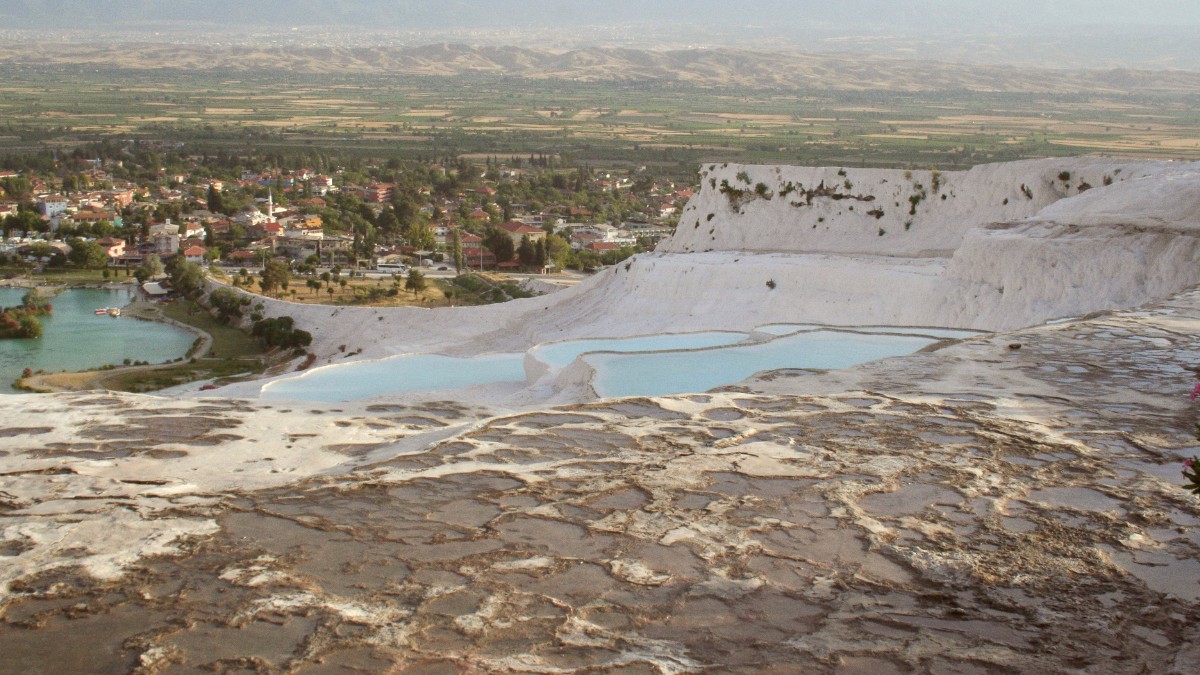
Aegean Coast, Turkey
The surrounding landscape offers a contrast. Fertile plains and valleys, fed by rivers and agricultural activity, surround the site. Then, the stark white of Pamukkale's travertines towers, a striking geological feature against the green backdrop. This geographical placement in the inner Aegean means it experiences a transition between the Mediterranean climate of the coast and the more continental climate of central Anatolia, influencing its weather patterns and the types of vegetation seen around the travertines.
The immediate area around the travertines features small, natural pools where visitors wade in the warm, mineral water. This direct interaction with the water forms a central part of the Pamukkale experience. Protecting these delicate formations is important.
Authorities implemented measures, like designated walking paths and a barefoot rule, for the preservation of the natural beauty and integrity of the site for future visitors.
Adjacent to Pamukkale's white travertines sits the ancient Greco-Roman city of Hierapolis. This historical city adds a profound layer of cultural importance to the natural wonder. Founded in the 2nd century BCE, Hierapolis thrived due to its thermal springs, believed to possess healing powers. This reputation transformed it into a major healing center, attracting people from across the Roman Empire seeking cures and relaxation.
Under Roman rule, Hierapolis grew into a large and prosperous city in Asia Minor. Its strategic location, combined with the therapeutic waters, led to its prominence. Evidence of its prosperity and architectural grandeur remains visible in the extensive ruins. The city experienced various periods of construction and destruction, notably from earthquakes. Each rebuilding effort further shaped its urban landscape.
Believed site of Apostle Philip's martyrdom, an octagonal pilgrimage structure.
A well-preserved theatre demonstrating intricate stage decorations and panoramic views.
A vast ancient cemetery with diverse tomb types, insights into burial practices.
Swim amidst submerged Roman columns in warm thermal waters.
Pamukkale and Hierapolis hold global importance, supporting preservation.
The ruins of Hierapolis provide a window into daily life in a bustling Roman city. A visit here goes beyond sightseeing; it connects travelers with ancient history and offers a dynamic natural process firsthand.
The Roman Theatre, with its intricate stage decorations and seating for thousands, offers panoramic views of the city and the distant plains.
The Antique Pool, often called Cleopatra's Pool, permits swimming amidst submerged Roman columns. These columns, remnants of a temple or portico, fell into the natural thermal spring during an earthquake. The warm, clear water creates a captivating experience.
Image of Pamukkale Travertines and Hierapolis City
A quick overview to set expectations for your Pamukkale visit. This information provides context for planning and understanding the local environment. It covers aspects like location, main attractions, common activities, climate, currency, time zone, and language.
Pamukkale is in the Denizli Province, within Turkey's Aegean Region. Its inland position gives it a distinct climate from coastal areas, though it retains Mediterranean characteristics.
Denizli Province, Aegean Region, Turkey
Hot, dry summers; mild, wet winters.
Turkish Lira (TRY)
The Pamukkale Travertines are the most recognizable feature, a natural phenomenon of white calcium terraces. Adjacent to these terraces is the Hierapolis Ancient City, a sprawling archaeological site with Greco-Roman ruins. The Antique Pool, or Cleopatra's Pool, offers an unique thermal bathing experience amid ancient columns. These three sites form the core of the Pamukkale experience.
Turkey operates on GMT+3. Adjusting to this time zone is simple for most travelers.
Turkish is the main language spoken. In tourist areas, English is commonly spoken by staff and guides.
Turkish Lira (TRY) is the local currency. ATMs are available, and credit cards are accepted in many establishments.
Walking barefoot on the travertine terraces is mandatory. Carry easy-to-remove shoes.
Especially in summer, staying hydrated with bottled water is important due to the hot, dry climate.